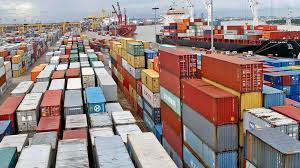Shipping companies operating at Apapa Port have started prioritising the discharge of import-laden containers over the evacuation of empty units due to a sharp and sustained surge in cargo volumes. This move is contributing to a growing backlog of empty containers, further congesting terminal yards and creating ripple effects across the entire logistics and supply chain network.
Port users and logistics operators have raised concerns over the congestion at APM Terminals Apapa, alleging that the terminal operator has halted the reception of empty containers. This has sparked frustrations among truck operators, consignees, and inland container depots, many of whom rely on timely return of containers to maintain the flow of cargo.
In response to these concerns, the Terminal Manager of APM Terminals Apapa, Mr. Steen Knudsen, issued a clarification, explaining that the current situation is not due to operational inefficiencies on the part of the terminal. Instead, he described it as a systemic imbalance in the global container traffic.
Knudsen stated, “Shipping lines own and control the containers. The management of empty container evacuation and their loading onto vessels is the sole responsibility of the shipping lines, not the terminal operator.” According to him, the recent spike in import cargo volumes has led shipping lines to prioritise the discharge of import-laden vessels, sidelining the evacuation of empty containers in the process.
This shift in focus has caused a buildup of empty container inventory in the terminal, significantly limiting the available yard space and leading APM Terminals to temporarily restrict the acceptance of additional empty units.
“We understand the implications for the broader supply chain,” Knudsen acknowledged. “Truckers, off-dock terminals, and importers are feeling the pinch. We’re doing all we can within our operational capacity to support shipping lines in clearing this backlog.”
Knudsen stressed that APM Terminals is currently engaging with shipping lines and relevant government agencies to facilitate faster evacuation of empty containers. He appealed to customers and other stakeholders to bear with the temporary inconvenience, assuring them that active measures are in place to ease the situation.
The congestion crisis highlights the long-standing structural issues in Nigeria’s port and logistics systems. Stakeholders have consistently pointed to the imbalance in import-export container flow, poor infrastructure, and bottlenecks in cargo handling processes as major obstacles to efficient port operations.
The effect of the backlog is now spilling beyond the ports. Many freight forwarders report delays in container returns, while some truckers face penalties from shipping lines for late returns of empty containers. Others are forced to hold on to empty containers, increasing demurrage costs and clogging up truck parks across Lagos.
Industry experts say that unless the current congestion is addressed, the port ecosystem could suffer more delays, especially with the rainy season approaching, which could slow down container movements even further.
Calls have been made for more collaboration between port authorities, terminal operators, and shipping companies, to develop long-term solutions. Some have suggested dedicated empty container holding bays outside the port and stronger policy enforcement from the Nigerian Ports Authority (NPA) and the Nigerian Shippers’ Council (NSC) to ensure balance in the inflow and outflow of containers.
Knudsen reiterated APM Terminals’ commitment to operational excellence and stakeholder engagement, but noted that without shipping line compliance in evacuating empties, terminal yard pressure will persist.
For now, many logistics operators and clearing agents are urging the government to intervene, calling for urgent action to restore fluidity in the Apapa Port system.
